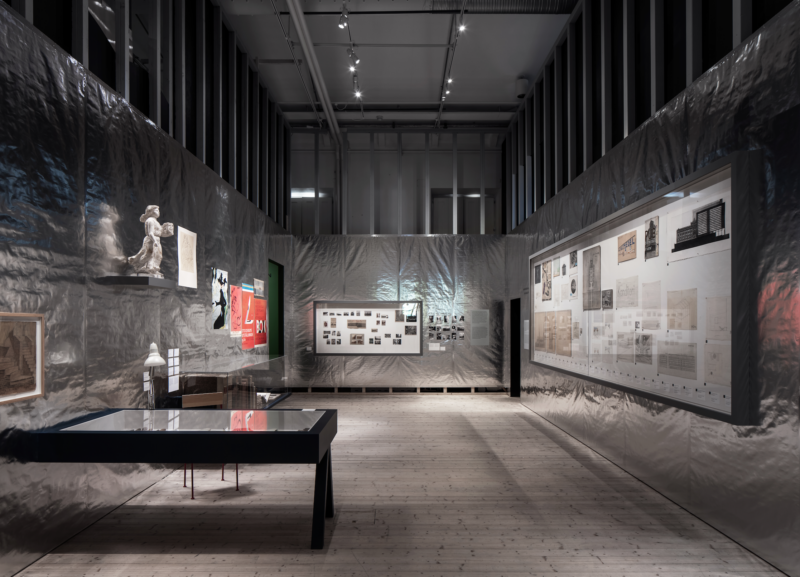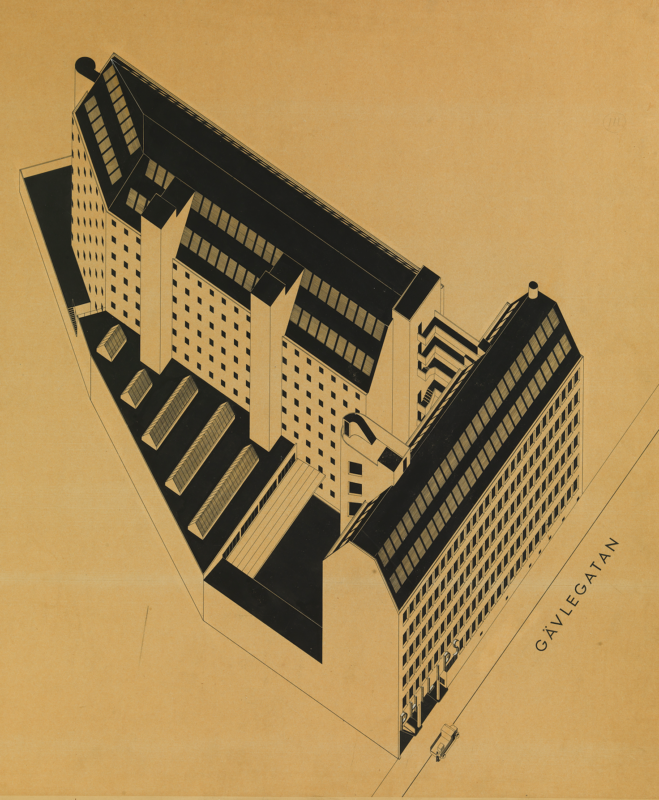From shopping to dying, a new Stockholm exhibition shows how the Swedish architect understood the human condition
 Photography by Johan Dehlin
Photography by Johan Dehlin
Words by Ellinor Thunberg
The first thing I notice when walking towards ArkDes’ comprehensive exhibition about the Swedish architect Sigurd Lewerentz (1885-1975) is the bold and bright lettering hanging from the ceiling. Graphic design studio Malmsten Hellberg’s signage is surprisingly colourful for leading the way to a show of an architect so widely associated with death.
Lewerentz’s iconic works – Woodland Cemetery (1915-40) and St Mark’s Church (1960) in Stockholm, and St Peter’s Church (1963-66) just north of Malmö – are sombre and monumental affairs, but I soon realise just how fitting the colourful letters are. There is more to Sigurd Lewerentz than meets the eye – and that’s one thing this exhibition at ArkDes wants to show.
A non-narrated film at the start of the show confirms the image we have been left with: the elderly architect visiting a construction site dressed in a long black coat and hat. We enter the first room, recreating the ‘Black Box’ – Lewerentz’s last studio space in Lund, which he used between 1970 and 1975. There, he spent a lot of time arranging the 13,000 drawings he ultimately left to ArkDes; the exhibition shows a total of 600 objects, most of them from the very same collection.
 Photography by Pål-Nils Nilsson featuring Sigurd Lewerentz outside St Mark’s Church
Photography by Pål-Nils Nilsson featuring Sigurd Lewerentz outside St Mark’s Church
Entering the Black Box is like getting a glimpse into Lewerentz’s imagination. The room is immersively lined with a metallic material, referencing the aluminium cardboard Lewerentz used to block out light in the original studio. The room is full of proposals, drawings, books from his library, as well as photographs and postcards.
It reminds us that behind every architect there is a hidden treasure of unbuilt projects and ideas, especially with a mysterious figure such as Lewerentz who rarely wrote about his work or spoke in public. But here we get to see his favourite coffee, what sweets he kept in his desk drawer, his old address book and the pencils he used for his thousands of drawings. It feels like being let in on a secret.
‘When I arrived in Sweden [in 2017], I realised there had never been a collections-based proper exhibition about the work of the greatest architect Sweden has ever had,’ says ArkDes director and curator Kieran Long. The opportunity to create an in-depth exhibition and a 700-page monograph about Lewerentz was one of the key reasons Long took the job and relocated from London to Stockholm.
 Photography courtesy of ArkDes
Photography courtesy of ArkDes
The exhibition, designed by Caruso St John Architects, is divided into six different areas. After the Black Box, we enter a green-painted room dedicated to the Woodland Cemetery in Stockholm – now a UNESCO World Heritage Site – and the Eastern Cemetery (1965) in Malmö, two of Lewerentz’s most important works. Proposals and drawings, including quirky and surprising elements not previously known, are on display.
The exhibition journey subsequently becomes chronological, and takes us into a small blue room offering insights into his early years, which also works as a kind of palate cleanser for what’s next: retail. In this cheerful room a patterned wallpaper designed by Lewerentz has been recreated, and the walls are filled with watercolour paintings created by his studio. The effect feels glamorous, glitzy and cinematic – almost like something straight out of a fashion house at the time.
The room showcases Lewerentz’s design work for the Stockholm Exhibition of 1930, which included the fair’s graphic identity, alongside temporary commercial pavilions. It also shows his detailed drawings of hotel interiors and shop exteriors. Here, the contrasting sides of Lewerentz’s work are revealed.
 Photography courtesy of ArkDes
Photography courtesy of ArkDes
‘Lewerentz is interested in shopping and death,’ says Long. ‘He is interested in the most shallow part of what it means to be a human, and the most deep. And nothing in between, because he knows that’s what it is like to be a human.’
The next phase – in life and the exhibition – focuses on Lewerentz’s years in the city of Eskilstuna, where he founded the Idesta factory, which created double-glazed window systems. This space also feels like a breather, a pause before entering the final room dedicated to Lewerentz’s two iconic brick churches: St Mark’s and St Peter’s.
The sequence of rooms has been cleverly building up to this moment – the grand finale of the exhibition as well as of the architect’s career. The projects are magnificent, and also show the importance of arts and crafts in Lewerentz’s process. ArkDes’ exhibition lets visitors get acquainted with Lewerentz on their own terms, no matter if they are already obsessed or if they are new to his work.
 Photography courtesy of ArkDes
Photography courtesy of ArkDes
‘You find the Lewerentz you need,’ says Long. ‘You turn up at his work and either see craft in it or you see process or commitment – there are all these things.’
I see an architect fascinated with contrasts, focused on extensive drawing as a method – and always surrounded by craftspeople and artists. Simply put, a mastermind.
Sigurd Lewerentz: Architect of Death and Life is at ArkDes in Stockholm until 28 August 2022
Get a curated collection of design and architecture news in your inbox by signing up to our ICON Weekly newsletter


















